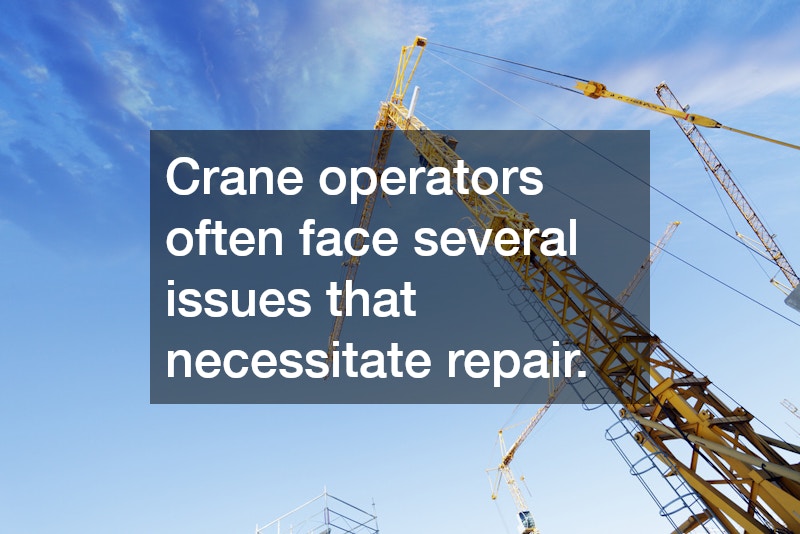In this article, we will explore the key aspects of crane repair, including common issues, maintenance practices, and choosing the right service provider. Cranes are essential equipment in various industries such as construction, shipping, and manufacturing, and their proper functioning is crucial to ensure safety and efficiency. Understanding the intricacies of crane repair can save operators and companies both time and money by preventing extensive damage down the line.
Additionally, with a deep dive into maintenance practices and an exploration of common problems, we aim to enhance your knowledge on how to extend the life of your crane. Safety should always be the primary concern for crane operators, and the right repair protocols can help in achieving this. Through this article, we will provide detailed insights to support crane operators in making informed decisions regarding crane maintenance and repairs.
Ultimately, being well-versed in crane repair not only benefits the operators but also enhances overall productivity on job sites. This article will guide you through various aspects of crane maintenance and repair, providing crucial information useful when faced with repair needs or service provider choices. With that said, let’s delve into some of the most common issues that may arise with cranes over time.
Common Issues in Crane Repair
What are the most common problems that require crane repair?
Crane operators often face several issues that necessitate repair. One of the most frequent problems involves hydraulic system failures, which can lead to poor lifting performance. Identifying these issues early often requires an acute understanding of the crane’s operation and periodic performance evaluations. Unaddressed hydraulic issues can have cascading effects on crane stability and safety.
Another common problem is wear and tear on the crane’s cables and rigging. Over time, these components may fray or stretch beyond safe operational limits, requiring urgent replacement. Regular inspection of these components is vital for maintaining not only the crane’s functionality but also the safety of all personnel involved in operations. Additionally, electrical system malfunctions can pose significant challenges, affecting the crane’s communication systems and operational controls.
These electrical issues may result in unexpected shutdowns or safety failures, making it imperative to ensure all wiring and control components are regularly checked. Dust, wear, and environmental factors can exacerbate these electrical problems, leading to either temporary malfunctions or prolonged outages requiring repairs. A thorough understanding of these common problems aids operators in ensuring effective crane operation and timely repairs.
How often should cranes be inspected and maintained?
Regular inspections are crucial for the longevity and safety of cranes. According to industry standards, cranes should undergo inspection at various intervals, depending on their usage and the environment in which they operate. Daily visual inspections are recommended along with more thorough checks annually or bi-annually. Compliance with these schedules ensures that potential issues are identified before they escalate into major repairs.
In addition to scheduled inspections, cranes should also be evaluated after extreme weather events or significant operational changes, such as heavy lifting sequences. These evaluations can help identify any atypical wear or structural changes that could affect safety and performance. Adhering to a strict maintenance schedule is a crucial part of effective crane management, minimizing downtime and extending equipment lifespan.
By fostering a proactive approach to inspections and maintenance, operators can better manage costs associated with crane repairs. This strategy also empowers operators to assess the condition of their cranes adequately and make informed decisions regarding necessary repairs. The result is heightened safety and efficiency in operations, contributing to overall project success.
How can a crane operator identify when repair is needed?
Crane operators should be vigilant for specific signs of wear and tear. Common indicators include unusual noises or vibrations during operation, which may signal underlying mechanical issues requiring immediate attention. Observing these symptoms can drastically affect machine performance, making it vital for operators to be attentive to what their equipment is communicating.
Other signals that repair is needed can manifest in operational inconsistencies, such as inconsistent lifting capabilities or decreased response time from operated controls. Monitoring these changes often allows operators to catch problems early, preventing costly repairs later. Furthermore, the presence of leaks in hydraulic systems can also indicate the need for immediate repair, as they can lead to complete system failures if left unaddressed.
Awareness and education about these operating signs can significantly enhance the safety and reliability of crane operations. Proper training should provide operators with the skills to assess when a crane needs repair accurately. This proactive identification can mitigate risks associated with operational failures and improve overall safety on job sites.
What should one look for in a crane repair service provider?
Choosing the right crane repair service is essential for quality workmanship. First and foremost, it’s vital to consider the service provider’s experience and expertise in crane maintenance and repair. Working with experienced technicians who understand the nuances of various crane models ensures high-quality repairs and minimizes downtime. Verifying credentials and certifications can provide reassurance regarding the provider’s capabilities.
Next, one should evaluate the service provider’s reputation within the industry. Positive reviews and testimonials from previous clients can offer insight into their reliability and performance standards. Additionally, a service provider’s ability to demonstrate a commitment to safety protocols during repairs should be taken into account, as safety is paramount in crane operations. Comparing multiple service providers helps to make an informed choice that aligns with budget and needs.
Lastly, timely communication and support offered by the service provider are crucial factors to consider. A responsive service team that understands the urgency of crane repairs can significantly reduce downtime. Establishing a good working relationship with your chosen repair provider can make future maintenance easier and more productive, ensuring your crane remains in optimal condition.




